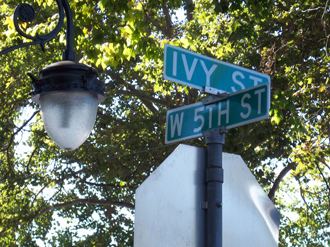Built 1860-1949 NRHP Reference # 91000636 Added to NRHP 24 June 1991 | Architect Multiple Area 210 ha | |
 | ||
Architectural style Queen Anne, Colonial Revival, Bungalow/Craftsman | ||
The South Campus Historic District is a historic district in Chico, California which was named to the National Register of Historic Places in 1991 through efforts of the Chico Heritage Association. The district is situated entirely within the South Campus Neighborhood. The historical district extends from Salem Street to Cherry Street, and from West Second Street to West Sixth Street. Whereas, the neighborhood extends from West Second Street south to West Ninth Street and west from Salem Street all the way to the city limits, which, in that area, is called the "Green Line." The South Campus Neighborhood Association represents the interests of the neighborhood to the community. There are several fraternity and sorority houses in the area, and the city has designated the South Campus Fraternity/Sorority Overlay Zone which is largely contiguous with the neighborhood and district.
Contents
- Buildings listed as contributing to the Historic District
- South Campus Neighborhood Association
- South Campus FraternitySorority Overlay Zone
- References
Historically, this area was the first residential area established in the city. The area was surveyed for laying out streets in 1860. South Campus is home of the Stansbury House, the Southern Pacific Depot, and the Language Houses.
Currently, South Campus is a dynamic residential neighborhood consisting overwhelmingly of young renters under thirty-five, and specifically Chico State students. It is one of the most densely populated areas of the city. The intersection of Fifth and Ivy Streets is a neighborhood commercial core referred to locally as "Five and I".
Buildings listed as contributing to the Historic District
The historic district consists of 114 individual buildings which have been named in the register as contributing to the historical district. They include:
South Campus Neighborhood Association
In September 1996, a group of residents, property owners, business owners, and student organization representatives got together to form the South Campus Neighborhood Association. This was, in part a result of the City Council, in May of that year, directing the Planning Commission to study zoning for "Student Living Groups" (i.e. fraternities and sororities, etc.). The group prepared a Constitution for the neighborhood association, and an outline for a neighborhood plan; both of which were presented at a neighborhood meeting in March 1997.
The association has successfully lobbied the city for increased lighting, infrastructure repairs (such as sidewalks), increased community involvement in police strategies, and amendments to the city's noise ordinance. The neighborhood association requested that the city consider creating a Special Events Permit, so as to address some of the issues arising from the youth of its residents. Although the city, did not establish such a permit, the proposed zone which was to be associated with this permit eventually was approved by the council as a unique Fraternity/Sorority Overlay Zone.
South Campus Fraternity/Sorority Overlay Zone
The land use regulations in the zone are combined with those of the base district, except that fraternities and sororities shall be a permitted use, with the approval of a ministerial permit by the Planning Director.
